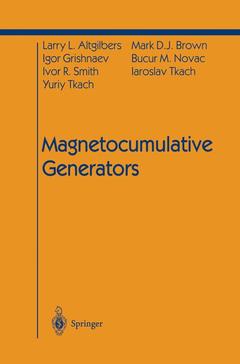Magnetocumulative Generators, 2000 Shock Wave and High Pressure Phenomena Series
Langue : Anglais
Auteurs : Altgilbers Larry L., Brown Mark D.J., Grishnaev Igor, Novac Bucur M., Smith Ivor R., Tkach Yuriy, Tkach Iaroslav
Préfacier : Fowler C.M.

Devices that convert explosive energy into electromagnetic energy are often called Flux Compression Generators (FCGs) in the United States, whereas the term Magnetocumulative Generators (MCGs) is more com monly used in Russia. Since the Russian literature is accessed more heavily in this book, the latter term is used here. In any event, the basic process involves using explosives to force an initial magnetic flux into a region of smaller inductance in such a manner that loss of flux is minimized. In the event that no flux is lost, the magnetic energy associated with the flux, inversely proportional to the inductance, must increase. Flux loss is min imized by confining it with good conductors which, in turn, are driven rapidly by the explosive to reduce the system inductance. The magnetic energy is increased by the work the conductors do as they are forcibly moved against the magnetic field, the energy, in turn, being supplied by the explosive driving them. As the reader may infer, there are different kinds of generators, some of which might be difficult to recognize as MCGs. Nonetheless, they all possess the features outlined above. Explosives have some unique features as energy sources. They have very high available energy densities; they release energy rapidly, or at high power; they can develop very high pressures.
1 Explosive-Driven Power Sources.- 1.1 Introduction.- 1.2 Overview of Explosive-Driven Power Sources.- 1.3 Magnetocumulative Generator History.- 1.4 Electromagnetic Theory.- 1.5 Electromagnetic Phenomena.- 1.6 Shock and Detonation Waves.- 1.7 Explosives and Explosive Components.- 1.8 Introduction to MCGs.- References.- 2 Magnetocumulative Generator Physics and Design.- 2.1 Conditions That Affect Magnetic Field Compression.- 2.2 Theory of Magnetocumulative Current Generators.- 2.3 Current Generator Design Issues.- References.- 3 Magnetocumulative Generators.- 3.1 Introduction.- 3.2 Classifications of MCGs.- 3.3 Coaxial MCGs.- 3.4 Spiral (Helical) MCGs.- 3.5 Plate MCGs.- 3.6 Loop MCGs.- 3.7 Disk MCGs.- 3.8 Semiconductor MCGs.- 3.9 Cascaded MCGs.- 3.10 Short-Pulse MCGs.- References.- 4 Pulse-Forming Networks.- 4.1 High-Speed Opening Switches.- 4.2 Pulsed Transformers.- 4.3 Spark Gap Switches.- 4.4 Pulse-Forming Lines.- 4.5 High-Voltage MCG Systems.- References.- 5 Electrical Loads.- 5.1 Direct Connection to a Load.- 5.2 Connection Through Pulsed Transformers.- 5.3 Connecting Through an Electroexplosive Switch.- 5.4 Pulsed Transformer and Electroexplosive Switch.- References.- 6 Design, Construction, and Testing.- 6.1 A Brief Description of FLEXY I.- 6.2 Computer Models.- 6.3 Helical Generator Design.- 6.4 Construction of the FLEXY I.- 6.5 Testing the FLEXY I.- 6.6 Comparison of Theoretical and Experimental Results.- 6.7 Summary.- References.- 7 Experimental Methods and Techniques.- 7.1 Experimental Methods.- 7.2 Explosive Pulsed Power Laboratory.- 7.3 Testing Fast Switches and Conditioning Circuits.- 7.4 Magnetic Coupling between MCGs.- 7.5 Limitations of Helical MCGs.- 7.6 Summary.- References.- 8 Applications: Lasers and Microwaves.- 8.1 Lasers.- 8.2 High-Power MicrowaveSources.- 8.3 Direct-Drive Devices.- 8.4 Summary.- References.
Date de parution : 11-2012
Ouvrage de 422 p.
15.5x23.5 cm
Date de parution : 01-2000
Ouvrage de 422 p.
15.5x23.5 cm
© 2024 LAVOISIER S.A.S.



